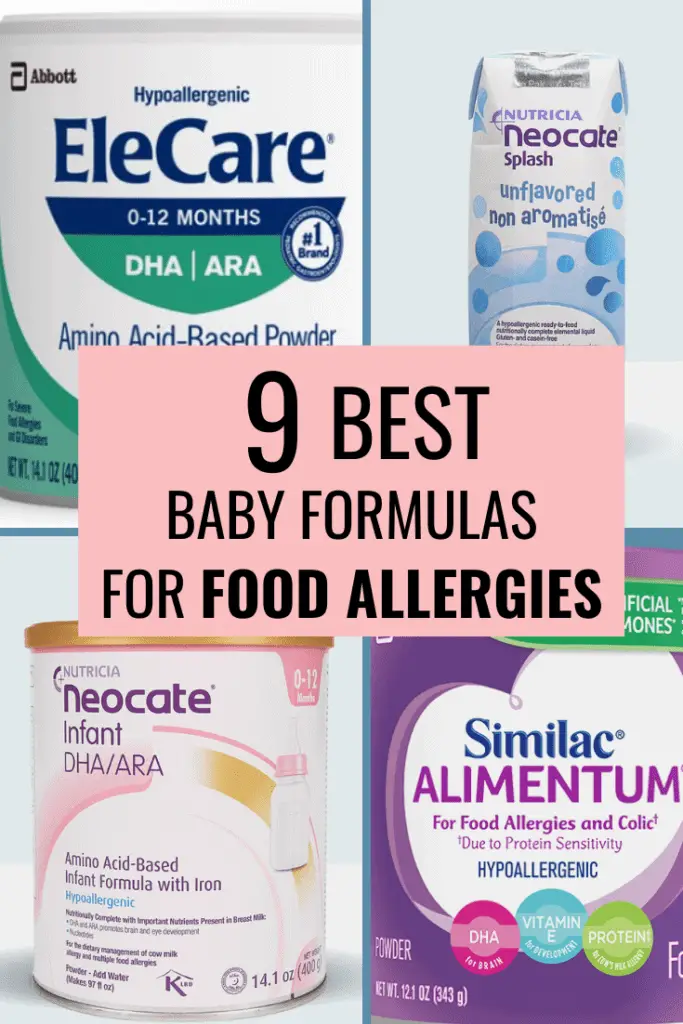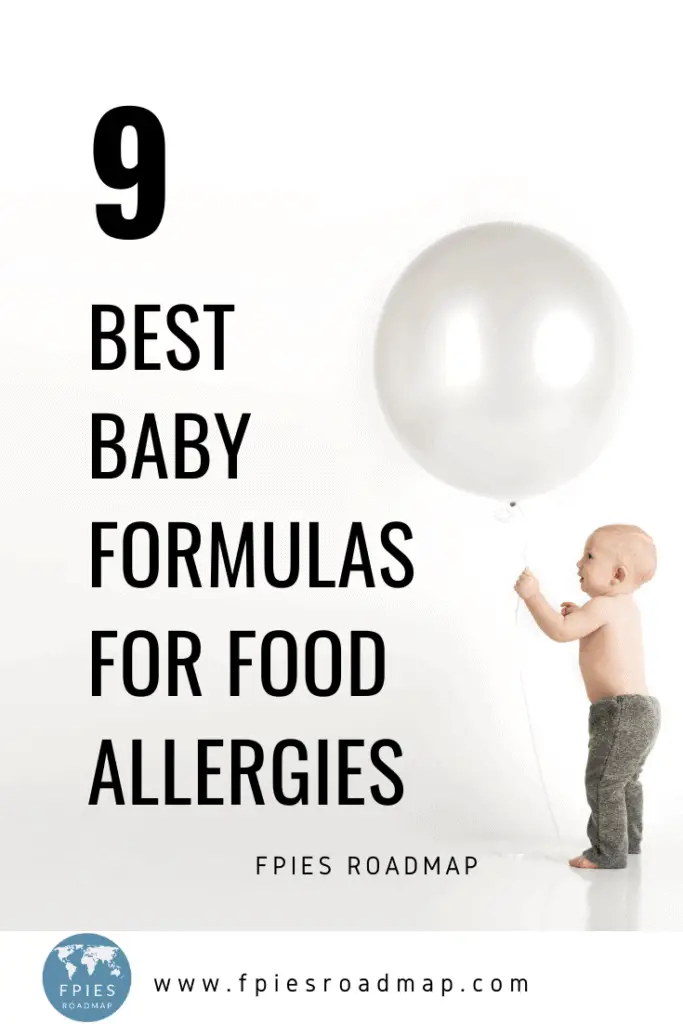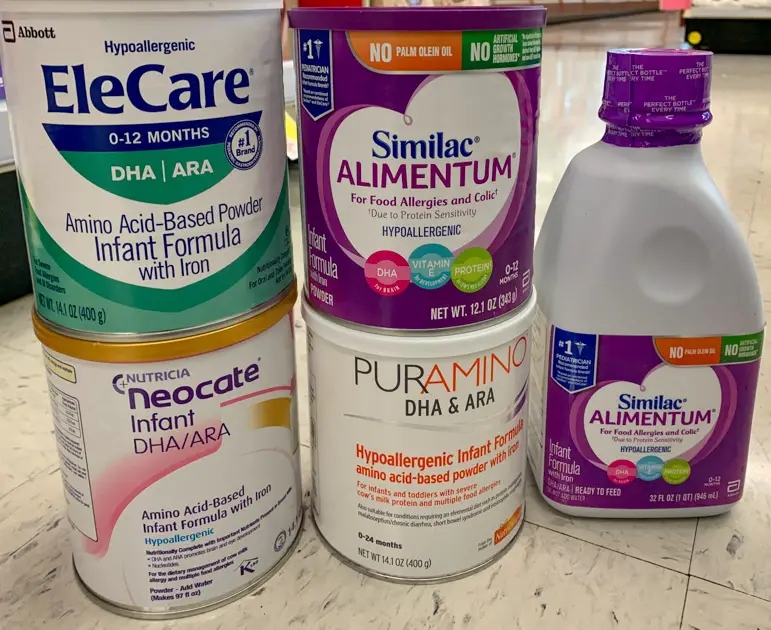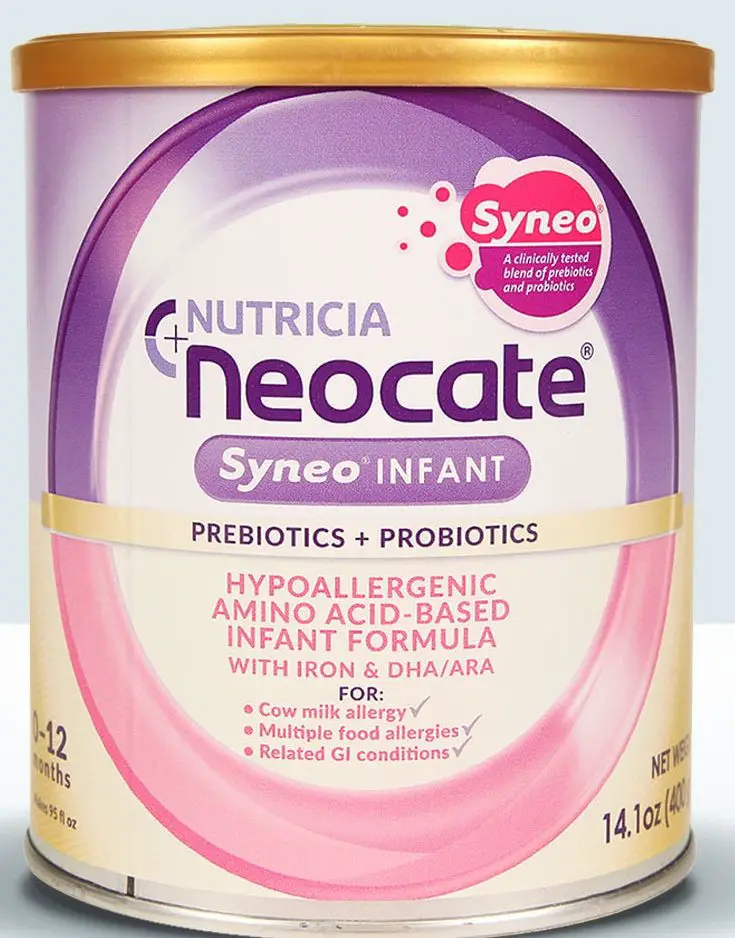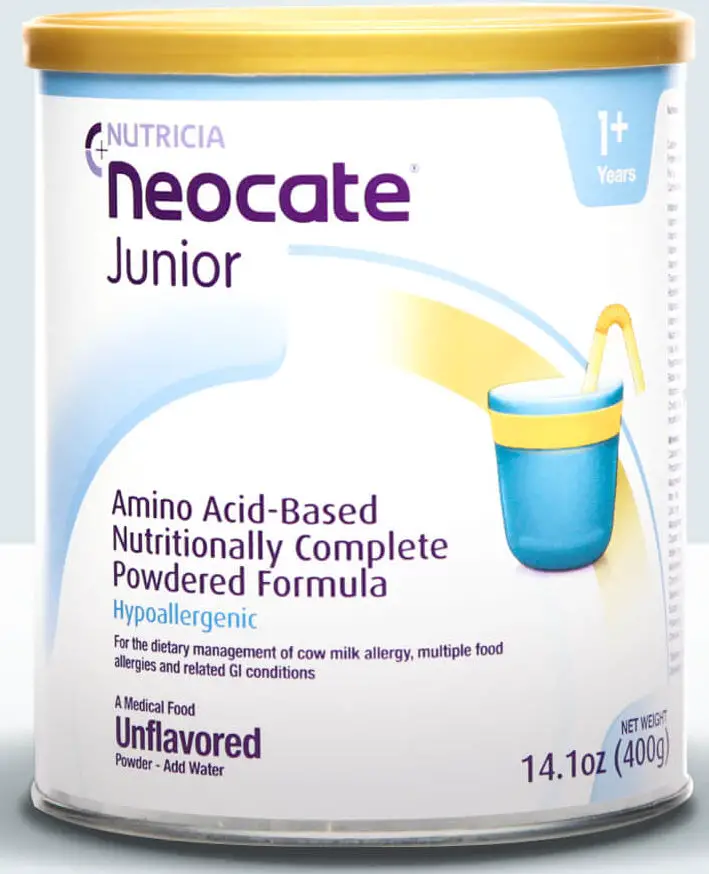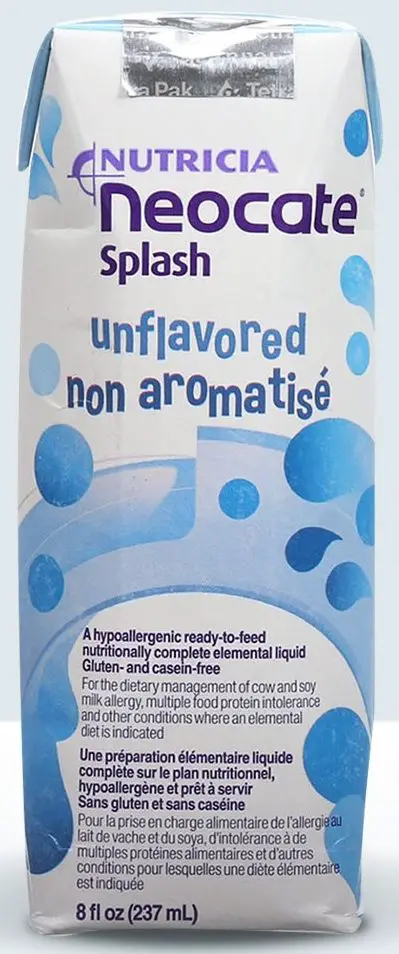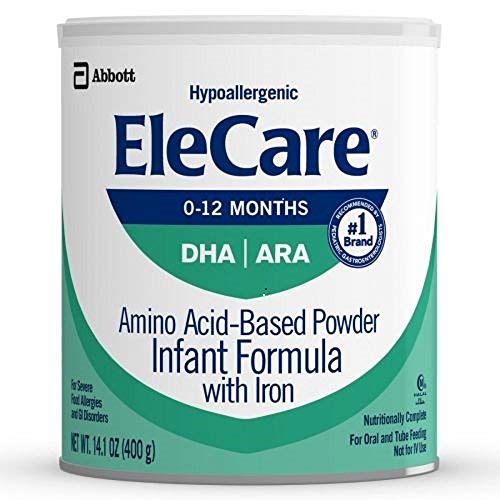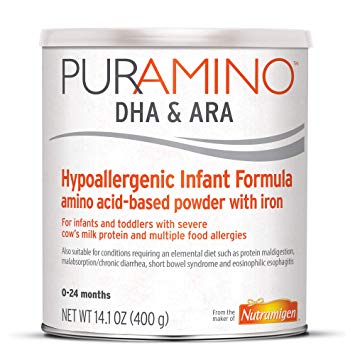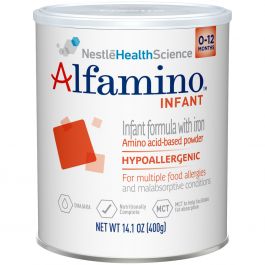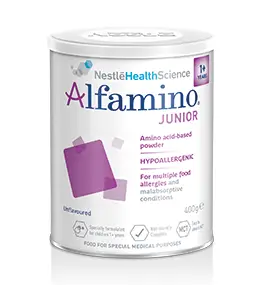I wasted a lot of time trying to find a formula that would work for my baby with food allergies. But, there are so many types of infant formulas out there, each one with different ingredients and different claims. Some say they are best for spit up, fussy baby, colic calm, etc. But if you have a baby with food sensitivities or IgG mediated allergies, you may not be able to just walk into a grocery store and pick a can off the shelf without your baby getting sick. In fact, if you are here looking, I’m willing to bet that you’re considering other options that would work for your child because the standard shelf options aren’t cutting it anymore.
There are several types of Infant and Toddler formulas that are made for children with food allergies or sensitivities. The first option is usually to try a hydrolyzed formula like Similac Alimentum or Enfamil’s Nutramigen. These types of formulas have dairy and soy in them but the proteins are broken down already to make it easier for babies to digest. Some babies still react to those small amounts of proteins and need elemental formulas that don’t have dairy or soy in them at all. These are amino-acid based formulas like Neocate or Elecare. There are some kids that react to elemental formulas as well who rely on modular formulas fed through G-tube or who rely on TPN to get their nutrition through a port or IV.
There are a few notes about starting new formulas for your child. First, and most important, do NOT try to do this without ongoing medical supervision. When you start a new formula, and especially when you enter the world of elemental formulas, there are a lot of variables that need to be considered; ingredients of the formula, the types of vitamins and minerals each formula has, and how many calories per fluid ounce your child needs to get enough nutrition. This should be managed by a doctor and possibly also a nutritionist. This site is just personal information about our experiences and should not be considered medical advice or a substitute for treatment by a licensed physician.
Secondly, when you start a new formula, you should stick with it for at least 2 weeks. It takes time to adjust to changes in formula for your baby, and sometimes it will take a while for the full effect (good or bad) of the new formula to show up. This is especially true if your child has dairy, wheat, or soy in their system – those foods take at least 2 weeks to work their way totally out of your body, so it can take quite a while before you see a huge improvement. That being said, if your child gets drastically worse once you put them on a new formula or if they have an acute type reaction to it, that may not be something you want to try to push through. Again, having a knowledgeable doctor that can help you out and see the symptoms you are seeing is the best thing.
Lastly, there may be some changes to your child’s poop when you start a new formula, especially if you are switching from breastmilk over to an elemental formula. Breastfed babies should have yellow poop that is soft but not liquid. Babies who are on amino acid based formulas usually end up with green poop (army green or forest green) that is more of a peanut butter consistency.
Hydrolyzed Formulas
Hydrolyzed formulas are usually the first option your doctor will recommend for you to try with your child if it seems like they are reacting to regular formula or breastmilk. Side note here: usually if a baby is tolerating breastmilk well, it’s better to try to eliminate trigger foods from the mom’s diet and see if issues resolve, but there are cases where switching to formula is necessary.
Hydrolyzed formulas are cheaper than using elemental formulas, and you can find them at most regular stores like Walmart or at the grocery store in the formula section. The two main options for hypoallergenic/hydrolyzed formulas are Nutramigen and Alimentum. Nutramigen is cheaper and it’s the one our doctor recommend trying first,but it didn’t work for either of my kids. Maybe Alimentum is a bit more broken down or maybe it’s just because the ingredients are slightly different, but my daughter was only able to tolerate Alimentum. My son wasn’t able to do either of those options and we moved on to elemental formulas with him. There is also a newer formula from Gerber called Gerber HA. It’s a broken down formula like the other two listed above and could be an option to try as well.
One big note about hydrolyzed formulas – they do still have dairy and soy in the formula. The dairy and soy proteins are very broken down (that’s why these are called hydrolyzed formulas), so many kids with allergies are able to do those just fine. Some of the more sensitive kids are still not able to tolerate any dairy or soy in their formula, and end up having to move to an elemental formula.
- Similac Alimentum
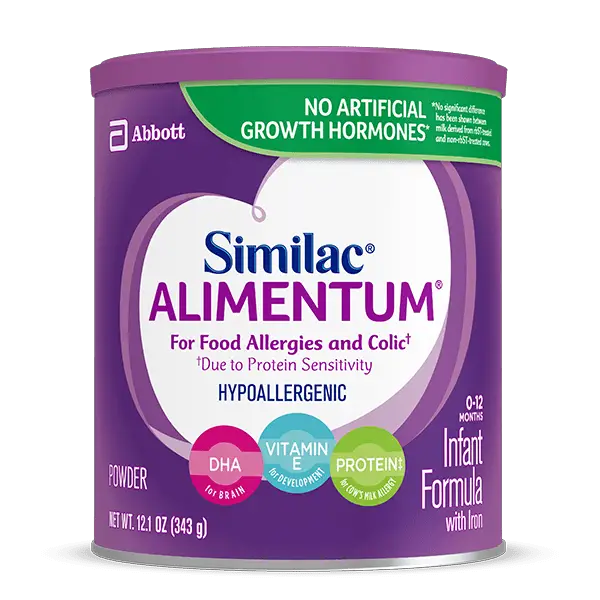
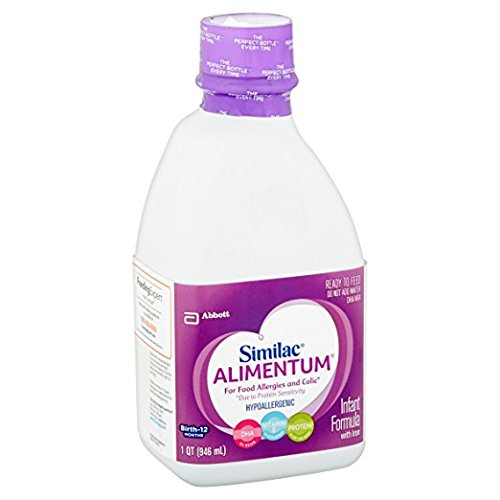
Similac Alimentum comes in two different varieties; there’s a powder option that you can mix up yourself, or there is a pre-mixed Ready to Feed version that doesn’t have corn in it. The powder is quite a bit cheaper (I used to get the cans of powder on Amazon, but you can also purchase it at grocery stores or chains like Walmart for a little bit more).
The main benefit of the pre-mixed version, called Alimentum Ready to Feed, is that it doesn’t have corn in it. There are quite a few kids who react to dairy that also have sensitivities to other food proteins as well until their digestive system starts to fully mature. If corn is an issue, this could be an option your doctor would have you try to see if your child could tolerate it. - Enfamil Nutramigen
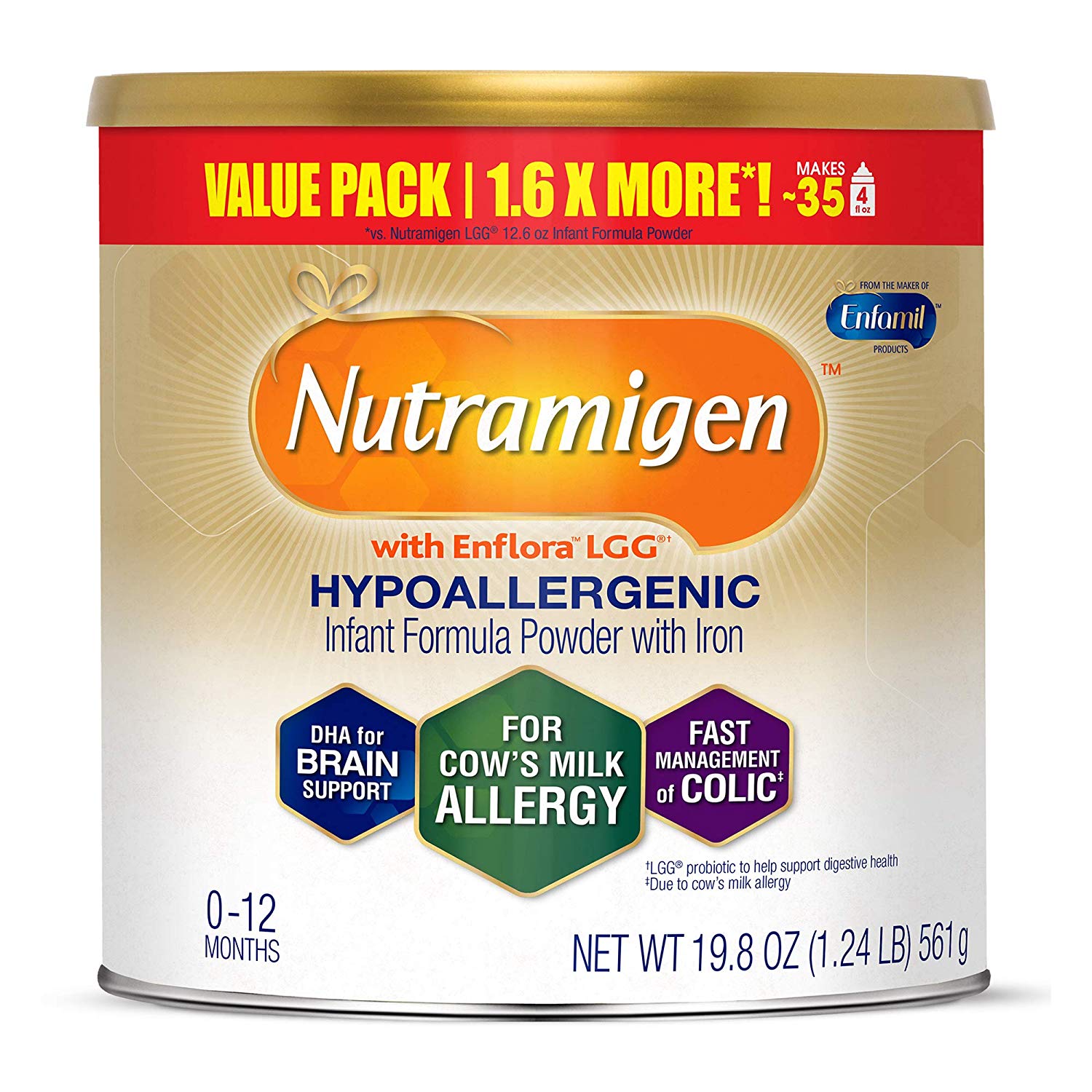
Enfamil also makes a hydrolyzed formula called Nutramigen that is similar to the Similac Alimentum. It’s a bit cheaper, so a lot of doctors will have you start with this option and work your way up to the Alimentum if this doesn’t work. One difference between this and the Alimentum is that Nutramigen has MCT oil, which has coconut. I think that was the reason my daughter was unable to tolerate this but did ok with the Alimentum.
This one can also be purchased at most stores that sell baby formula, and can also be purchased on Amazon in larger quantities for a cheaper price.
There is also a junior level of this formula, for kids that are still sensitive or need extra nutrition after they turn 1. - Gerber Extensive HA
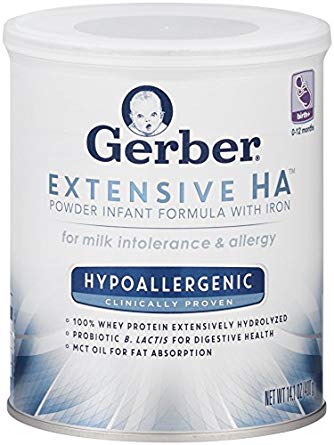
Gerber Extensive HA is another option for those looking for a formula with the proteins already broken down. It wasn’t around when my kids were small enough for formula, so I honestly don’t have an opinion on this one either way. There do seem to be good reviews on Amazon, but I have no idea how well it would work for a baby with FPIES or very severe milk or soy protein intolerances. Check with your doctor first and proceed per their instructions.
Elemental Formulas
Elemental formulas are amino acid based, instead of using dairy. These include Elecare, Neocate, PurAmino, and Alfamino. Neocate is the only one of those that has no soy oil, so if your child is extremely sensitive to soy, you might want to look at Neocate first. The soy in the others is so broken down that most children will likely do fine with it, but there are some that are just super sensitive. The ingredients in these formulas usually have a heavy amount of corn, so if your child is very corn sensitive these may not work as well. Side note- many corn sensitive kids do well with the Ready to feed (pre-mixed) version of Alimentum.
These formulas also usually have a junior version for children over the age of 1 who still need formula as a main or supplementary source of nutrition. The junior formulas are adjusted slightly to account for increased calories and nutrients your child will need as they get older. There are several different options for infant and junior formulas through Neocate and Elecare and it can get a little confusing, so keep reading for a breakdown of the different options. Things can change quickly as technologies develop, so do your own research and ALWAYS read the labels. Remember, this is only a guide. Moving to a formula should always be something you do under medical advice and ongoing supervision.
Neocate Formula Options:
Neocate Syneo is the newer version of the regular Neocate Infant formula. This version contains prebiotics and probiotics to try to help seal up leaky gut issues and help with inflammation. According to Neocate, it’s supposed to make the baby’s gut flora closer to what a breastfed baby’s is like. This does have more ingredients than the regular Neocate below, so if your child doesn’t react well to the Syneo version you could still try the regular Neocate Infant because the ingredients are slightly different.
- Neocate Infant (Neocate Gold in Australia or Neocate LCP in other countries)
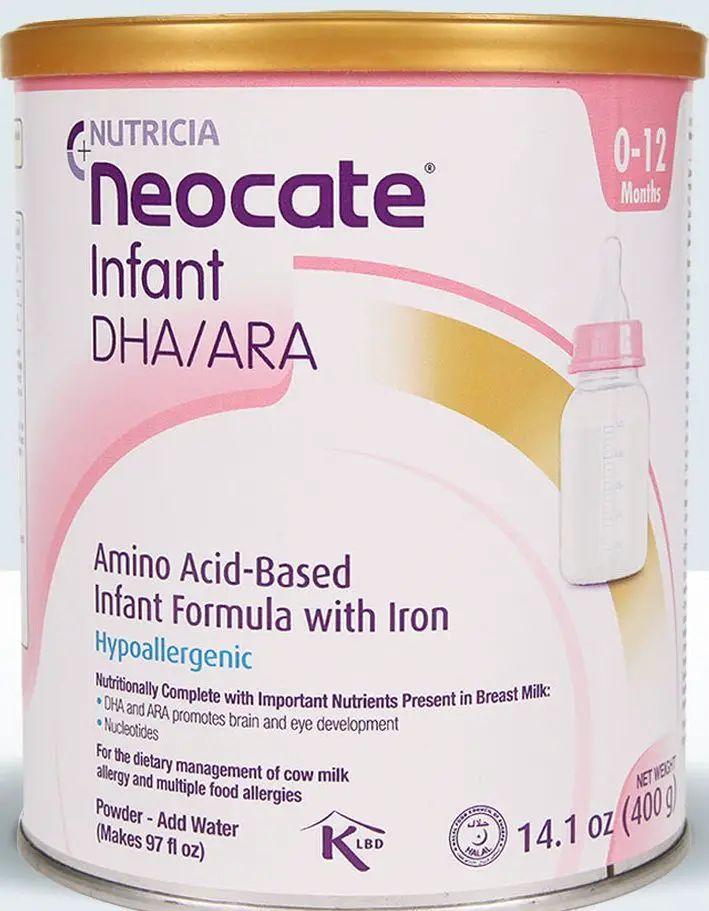
This is the original Neocate Infant formula. This is for babies up to 12 months of age. Babies over one should use the Junior formula described below. In some cases I have heard of babies that need to stay on the infant formula past one year of age. This should only be done under a doctor’s supervision because the doctor will need to calculate the amount of calories per fluid ounces your child needs past one year of age and the formula will need to be mixed at a higher concentration than the labeled instructions.
Neocate Junior comes in two different types with a variety of flavors for each type.
- Neocate Junior without Prebiotics only comes Unflavored (pictured). The unflavored version seems to have the highest pass rate from the FPIES families I’ve seen, but the taste is not great. If you are having trouble getting your baby to even drink enough for a trial, check out my best tips for getting babies to drink elemental formulas.
- Neocate Junior with Prebiotics – Comes in Unflavored, Strawberry, Vanilla, Chocolate, and Tropical. Each of these flavors has different ingredients and may need to be trialed separately.
Neocate Splash comes in little juice box- type pouches. It’s a medical drink for nutritional supplementation but it is not considered a formula for babies under a year of age. These come in a case of 27 individual box/pouches (pictured) that are ready to use with a straw. Each little pouch is 237ml. These have several different flavor options as well: Grape, Tropical Fruit, Orange-Pineapple, and Unflavored. These are artificially flavored and will probably need to be trialed individually for kids with EOE or FPIES.
My kids were able to tolerate the unflavored version, as well as the Orange-Pineapple and the Tropical Fruit. I’ve heard that the grape doesn’t taste as good, but there are kids that do just fine on it.
Elecare Options:
Elecare Infant is another option in the elemental formula category. There is only one version/flavor so there’s no confusion here. Like the Neocate, it has DHA and ARA added and it’s considered a complete source of nutrition for babies under 12 months of age.
Usually, doctors will have you start with either Elecare or Neocate Infant to see which one will work because they are so similar. Elecare is a little cheaper, so we started with that for both of our kids, but ultimately we ended up only being able to do Neocate. Another benefit of Elecare is that some box stores sell it on their shelves. I’ve seen it in our local Walmart, which is more convenient than having to buy it online (even if it’s a quite a bit cheaper on Amazon).
Elecare Junior is tailored for nutritional needs for children over one year of age. It comes in several flavors; Unflavored, Vanilla, Chocolate, and Banana. Elecare does have soy oil in it, but it’s broken down so much that there are lots of kids with soy issues that still do well with it.
One thing to note about switching to a Junior level formula (whether it’s Elecare or another brand) is that the amount of scoops that you will need to use per fluid ounce is higher. Check the can before mixing the junior version, some of them require one scoop per ounce of water, and others have a guide on the back of the can with directions to mix it correctly. This was something that was an adjustment for us, because we started going through the cans twice as fast once we started on the junior formulas.
Puramino uses soy oil as well as tapioca starch, so if your child reacts strongly to soy or tapioca, this might not be one that will work for you. We actually found formula that my kids could tolerate without having to trial Puramino or Alfamino, so I don’t have personal insight into these two options. However, I know there are a lot of kids with FPIES that are able to tolerate one of these two varieties who may not have been able to do Neocate or Elecare. Just because they are at the bottom of my list doesn’t mean that they aren’t viable options. With food allergies, especially FPIES, you simply have to trial EVERYTHING. You never know when one option will work and another won’t.
Puramino has an unflavored infant version of their formula, as well as an unflavored Junior version and a vanilla flavored Junior version.
Alfamino is another Elemental formula that has both an infant and a junior version for kids over one year old. The base for this formula is somewhat similar to Puramino, except this one uses potato starch and the other uses tapioca starch. Alfamino also uses soy oil, so if you have a child that’s very soy reactive you may want to try Neocate first and then move to this if it doesn’t work. Both the infant and the Junior versions of Alfamino only come in an unflavored variety, but I’ve heard from several people that even the unflavored versions of this formula taste better than the unflavored options from Neocate and Elecare. Again, I’ve never tried this one personally and we didn’t have to use it for our kids, so I’m going off of what I’ve heard from other families.
What if none of these options work?
Sometimes, despite what should work or what works for most people, there are kids that just react to all of these options. One of the scariest spots we were ever in as FPIES parents was when we tried many of the formulas above for our son and he failed one after another. We met with his doctors several times over the course of a few months until we were able to find a formula that worked for him that he could tolerate.
There are several other options you can try if your child is reacting to all of the options above.
- Make sure that you’ve tried each option listed above. Some kids tolerate one of the flavored varieties of the formulas but they can’t do the unflavored variety. Sometimes only the junior formula is tolerated and you have to start a child under one year of age on one of the junior formulas early and mix it with extra water to dilute it. Other times, a child might only tolerate the infant version of the formula and must continue on it after one year of age using a more concentrated dose.
- Some babies are able to tolerate formula using alternative milks, like goat or camel milk. There are a couple of types of formulas that are made from goat milk in Germany – Holle and Hipp are two brands available. Goat milk and cow’s milk still have a very similar protein structure, so this should only be tried under a doctor’s supervision, especially if your child reacts strongly to dairy. Some also have had success with camel milk, either raw or in a powdered form that can be added to other ingredients to make a homemade formula. Again, this isn’t something that should be tried on your own. Consult with your doctor or nutritionist to make sure this is something that might work for you.
- Finally, some moms have success using donated breast milk. You can use a service like Human Milk for Human Babies, a milk bank, or even donations from local Le Leche League members in your area. Some moms have found that even when their breast milk causes a reaction, their baby is able to tolerate donated milk. Some people are even able to find milk from donors who are on allergy friendly diets or donors who avoid their child’s trigger foods.
Like with any food trials, this process is going to mostly be trial and error. Start with the hydrolyzed options and see if one of those works for your child. If not, move to the elemental options. If one brand doesn’t work, try the other. You may be surprised what actually works and what doesn’t. If none of these options work for your child, you can work with your doctor to see what the next steps would be for nutrition.
